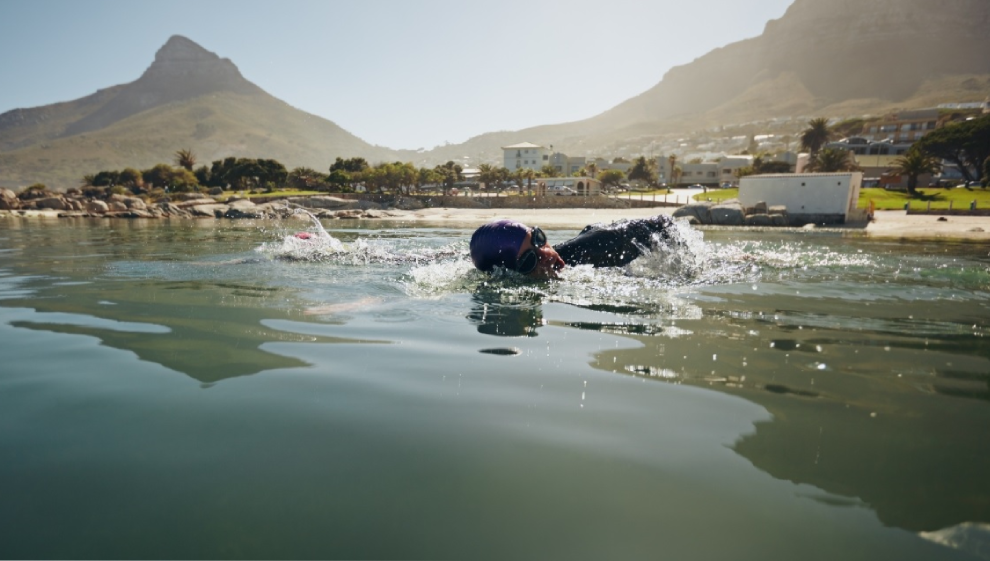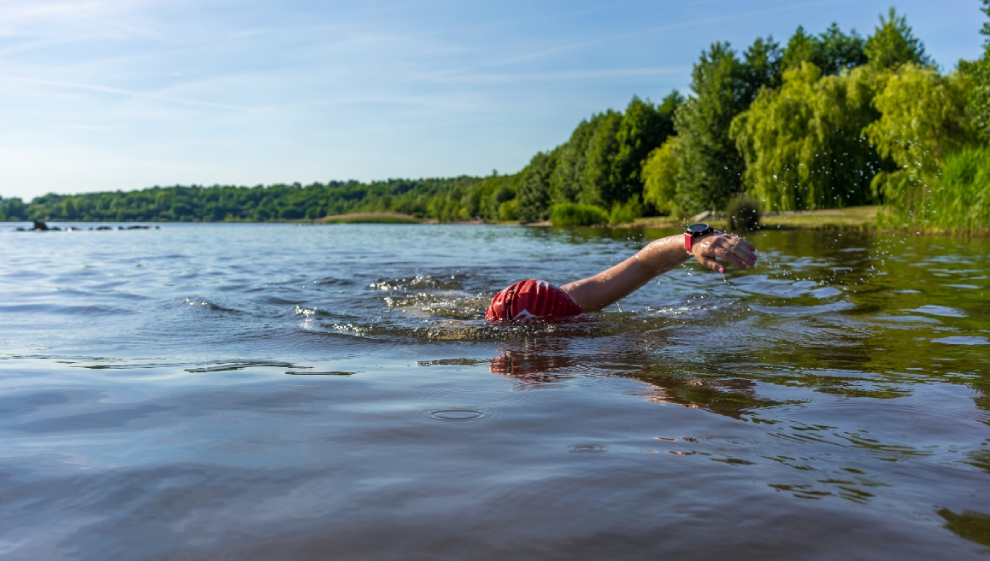Wild swimming | A beginner’s guide to open water swimming
Swimming in open water has boomed in popularity in recent years, making it safer and more accessible for everyone. Whether there’s a lake venue near you or you’ve got your eye on a quick dip in the sea this summer, there are a few things you need to know first.
How to start wild swimming
- Start small: if it’s your first time, take time to get used to the water. Currents, level and temperature changes, and cold-water shock all make open water a different proposition to your local leisure centre pool
- Purchase or hire a wetsuit: even in warmer months, wearing a wetsuit adds buoyancy to help you move through the water in a more aerodynamic fashion
- Educate yourself: open water can be unpredictable, so asking for advice from someone at the venue can be invaluable
- Don’t get discouraged: there’s a reason you won’t match your ability in the pool. Open water is choppy, unpredictable, and cold, making it harder to swim in than your local pool
- Enjoy yourself: with all that in mind, have fun. Open water swimming is an adventure that you can’t replicate in a pool. Find what you love best about wild swimming and embrace it.
What is wild swimming?
Wild swimming (or open-water swimming) is the act of swimming in natural, unchlorinated water. This immersive experience gives you a freedom that you can’t get in a pool and allows you to swim in the face of breath-taking views and landscapes.
It has been a traditional activity in the UK for centuries and is enjoying a resurgence because of its affordable and has a positive impact on our mental and physical health and well-being.
Swimming at Nuffield Health
If you prefer the thought of indoor pool swimming, why not try one of the 113 heated swimming pools located at our fitness and wellbeing centres up and down the country?
We’re proud to offer everything from swimming lessons and pool-based activities to family splash classes and designated lane times for adults.
Is wild swimming legal in the UK?
Yes, there is currently no law prohibiting wild swimming in the UK. What does this mean in practice? In England and Wales, there is a “right to roam” law that means you can take to swimming in most lakes and rivers. There are some exceptions that can prohibit this right, so it’s best to check beforehand to avoid any potential issues.
Is wild swimming safe?
Depending on where you are and how deep the water is, you may have nothing to worry about. A good rule of thumb is if you can’t safely stand, always weigh up the potential for danger.
If you’re mindful of danger, the likelihood is you’ll be fine. For beginners, we advise staying close to the edge until you feel comfortable with the water temperature and buoyancy. Open water swimming feels a lot different to your local pool, so take some time to climatise.
Things to look out for
Unlike in a pool, you usually wont be able to see the bottom of a lake or river. This means you need to be extra vigilant and look out for potential hazards and dangers before you encounter them. This is especially true if you're swimming with young children.
This includes things like:
- Areas where the current or tide changes
- Depth changes and 'drop offs'
- The temperature of the water
- The weather and conditions overhead
- How tired you or your kids are
- Wildlife in the area
- The cleanliness of the water you're swimming in
- Your entry and exit points
The importance of water quality
A big wild swimming talking point in the UK at the moment is whether or not it's safe to swim in open water rivers and lakes because of the poor quality of our water systems.
Some studies have even deemed our waterways unsafe for wild swimming, citing pollution and contaminated waterways as two of the main reasons why people should avoid swimming in the sea.
Despite challenges, there have been efforts to improve the situation. A record number of wild swimming spots have been designated as bathing sites, which means they now receive regular monitoring for water quality.
If you want to find out more about the open water quality in the UK, use the interactive map below to assess the situation at a wild swimming spot near you:
Top tips for improving your technique
If you feel like you’re learning to swim all over again, you’re not alone. Swimming in a choppy reservoir can feel like an altogether different activity from gliding through the water at your local pool. Concentrating on homing in the fundamentals of each stroke is a great way to find your feet in open water.
Take a look at the information below to refresh your memory on the importance of correct form when swimming:
- The correct way to swim backstroke
- The correct way to swim front-crawl
- The correct way to swim butterfly stroke
- The correct way to swim breaststroke
Do I need to wear a wetsuit?

What to wear when you’re wild swimming is a good question. If you’re used to swimming in a pool, you might disregard a wetsuit as an unnecessary precaution.
Depending on the temperature of the water and your ability as a swimmer, you might want to consider wearing one.
A wetsuit partially eliminates any worries about the temperature of the water and also streamlines you in the water which is a big help for beginner open water swimmers.
A correctly fitted wetsuit should be slimline but comfortable to prevent chafing and itching. If you’re allergic to a particular synthetic material, consider researching alternatives before you buy or rent a wetsuit.
What are the health benefits?
Aside from being an enjoyable way to cool down during summer, open water swimming has several health benefits that you can’t simulate in a pool.
- A well-rounded workout: the full-body benefits of swimming are no secret. The currents that you get in open water only add to this, activating additional muscle groups to keep you afloat
- Mental wellbeing: the natural aspect and serene environments associated with wild swimming are great for our mental health. The calming effect of the water can also help with anxiety and stress
- Cold-water therapy: wild swimming in cold water stimulates the release of endorphins, improves circulation, and reduces inflammation
- Social interaction: organised open water venues are a great place to meet people who share your love of swimming and the great outdoors.
Wild swimming near me
In the UK there’s no end to great natural water spots for you to visit and swim in. Some of the best spots are in Scotland, Wales, and the south of England, giving you an array of options to choose from.
These range from reservoirs and lakes to rivers, streams and of course, the sea. Finding a spot near you couldn’t be easier. Take a look at some of our favourites, below:
- Blue Lagoon, Pembrokeshire (Wales)
- Bude Sea Pool, Cornwall (England)
- Scolt Head Island, Norfolk (England)
- Dorothea Quarry, Nantlle Valley (Wales)
- Hampstead Heath, London (England)
- Fairy Pools, Isle of Skye (Scotland)
- Port Meadow, Oxford (England)
- Falls of Falloch, Crianlarich (Scotland)
- River Stour, Kent (England)
- River Dart, Devon (England)
Is swimming in open water harder?

Depending on your environment, open water swimming can feel a lot harder than swimming in a pool. This is because the water is choppier and more resistant, making it harder for the body to move through.
It’s wise to consider the amount of fatigue you’d normally feel in a pool and build up to that level over time. Remember, there isn’t the opportunity to catch your breath at the side of the pool or get out after five lengths for a breather.
The temperature of the water is also a lot lower, meaning your muscles may cramp or cease up if you’re a beginner. Cold water shock is a real threat to consider if you’re planning on wild swimming during the winter months. Consider wearing a wetsuit and swimming cap if you’re apprehensive about cold water exposure.
A wetsuit isn’t just for guarding against the cold. It also improves buoyancy out on the water because your body becomes more streamlined. This can really help if you’re transitioning to open water or if you’re new to wild swimming.
Using the pool for training
Wild swimming should be viewed differently to swimming in the pool. Whether you’re training for a triathlon or you’re looking for something new to try with your family this summer, wild swimming brings with it a unique set of considerations when compared to your local pool.
For best training results, continue to tackle the bulk of your swimming routine or plan indoors. Pools are better conditioned to long-term water exposure and the facilities on offer make for a more comfortable experience if you’re swimming regularly.
If you are training for an outdoor event, introducing one outdoor session a week helps to gradually climatise you to this new aquatic environment. Chart your progress in open water as part of your plan (as you would a long run if you’re a runner) whilst continuing most of your training indoors at your local pool.
For more information about training plans, take a look at our range of plans below:
- Beginner swimming pool training plan
- Intermediate swimming pool training plan
- Advanced swimming pool training plan
Last updated Wednesday 29 May 2024
First published on Tuesday 1 August 2023
